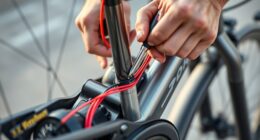Commuting is often seen as a tedious task. Amid the rush and demands of daily routines, it can be challenging to muster the energy and time to move from one location to another. However, imagine if there was a way to simplify your daily travels. Picture using a bicycle that’s not only comfortable and dependable but also fashionable. Indeed, a growing number of women are discovering that hybrid bikes are the perfect solution to their commuting challenges!
In recent years, hybrid bikes have become increasingly popular among female commuters. These bikes offer the best of both worlds—a mountain bike’s ruggedness combined with a road bike’s speed and agility—making them perfect for those long-distance commutes. Not only are they great for getting around town quickly, but they also provide an enjoyable ride with plenty of comfort. And with so many options on the market today—from simple single-speed models to high-end electric hybrids—there is something out there for everyone’s needs.
For many women, hybrid bikes offer a sense of freedom and empowerment. Not only do they provide an efficient way to get from point A to point B without breaking a sweat, but they also allow riders to explore new places in their own unique way. Whether you’re looking for a reliable workhorse or just want to add some style to your daily ride, hybrid bikes offer something for everyone—and that’s why more and more women are choosing them as their go-to option for their daily commute!
Benefits Of Hybrid Bikes
The idea of commuting to work in the city can be intimidating. Navigating busy streets filled with cars, buses, and other cyclists can feel overwhelming. But what if there was a way to make this commute more comfortable? Enter hybrid bicycles: the perfect blend of mountain bikes and road bikes designed specifically for city cycling.

Hybrid bikes offer numerous benefits that make them an ideal choice for commuters looking for an efficient and enjoyable ride. They feature a lightweight frame, wide tires, and flat handlebars that allow you to keep your back straight while cycling—all of which help you stay alert during your ride. Plus, they’re equipped with multiple gears so you can adjust your speed as needed when navigating uphill or downhill terrain.
But perhaps the biggest benefit of hybrid bicycles is their versatility. From long-distance commutes to weekend rides around town, these bicycles are suitable for a variety of cycling needs. Whether you’re looking for a fast-paced ride through the city or a leisurely cruise through nature’s beauty, hybrid bikes will get you there in style and comfort. With all these advantages, it’s easy to see why more women are choosing hybrid bikes for their commute.
Different Types Of Hybrid Bikes
When it comes to hybrid bikes, there are many different types to choose from. From city hybrid bikes to mountain hybrids and comfort hybrids to road hybrids, you’ll be sure to find one that suits your needs. Let’s take a closer look at each type:
City Hybrid Bikes: These bikes are designed for urban commuting and feature flat handlebars that help keep your back straight while cycling. They also have wide tires and multiple gears so you can adjust your speed as you pedal through busy streets. With their combination of speed and maneuverability, city hybrid bikes are the perfect choice for commuters who want an efficient ride in the city.
Mountain Hybrid Bikes: Mountain hybrid bikes combine features from both mountain bikes and road bikes, making them suitable for off-road riding as well as urban commuting. They typically have wider tires, which provide more stability on rough terrain, as well as front suspension forks which absorb shock from uneven trail surfaces. Whether you’re looking for an exciting weekend ride or a comfortable commute to work, mountain hybrid bikes offer the perfect balance of performance and comfort.
Comfort Hybrid Bikes: Comfort hybrid bicycles are designed with upright geometry so riders can remain upright while cycling—perfect for those who don’t want to hunch over during their commute or leisurely ride around town. These bicycles usually have wider seats and adjustable handlebars so riders can customize their comfort level. Plus, they often come equipped with full suspension systems that absorb shock from bumps in the road or trail surface—allowing you to travel in style without sacrificing comfort!
Road Hybrid Bikes: Road hybrid bicycles combine features from both road bikes and mountain bikes and are great for long rides on paved surfaces such as roads or bike paths. They often have narrow tires which provide less rolling resistance than wider tires, allowing you to reach higher speeds with less effort. Additionally, these bicycles typically have drop bars which allow riders to get into an aerodynamic position—ideal for those looking for a fast-paced ride without compromising comfort or safety.
Clearly, there is no single ‘best’ type of hybrid bicycle—it all depends on what kind of riding you plan on doing and how comfortable you want to be when doing it. With so many different options available, finding the right bike will take some research and trial-and-error—but it will be worth it when you find the perfect fit!
Factors To Consider When Buying A Bicycle
Now that you’re familiar with the different types of hybrid bikes, it’s time to start looking at all the factors to consider when buying a bicycle. It can be overwhelming trying to decide which bike is right for you, so take a deep breath and arm yourself with the knowledge of what to look out for. From bike size and frame material to gear system, suspension type, and wheel size—these are all important considerations when selecting your ideal ride.
When it comes to bike size, choosing one that fits your body correctly is key. You want to make sure you have enough room between the handlebars and your seat so you don’t feel cramped while cycling. The frame material is also an important factor; lighter materials will require less effort on your part while riding but may be more expensive than heavier frames made from steel or aluminum.
The gear system and suspension type will also affect how easily you can pedal up hills or maneuver around tight corners. Look for a bike with multiple gears so you can adjust your speed as needed, and if you plan on riding over bumpy terrain consider investing in a full suspension system for added comfort and control. Finally, wheel size should be taken into account; wider wheels provide better momentum and stability on flat surfaces but may not be suitable for tight corners or steep inclines.
After considering all these elements carefully, you’ll be able to narrow down your choices and find the perfect hybrid bike for your needs! With this decision out of the way, let’s move onto exploring the advantages of cycling for commuters.
Advantages Of Cycling For Commuters
Cycling has long been a popular form of transportation, and in recent years more and more people—especially women—are choosing to commute by bike. It’s no wonder why: cycling provides a number of advantages for commuters, including health, environmental, and economic benefits. Here are the top three reasons why more women are opting for hybrid bikes for their commute:
1) Cycling is good for your health: Regular cycling can help improve cardiovascular health, strengthen your muscles, and reduce stress. Cycling to work also gives you an opportunity to start your day with some physical activity instead of sitting in traffic or on public transport.
2) Cycling is better for the environment: By cutting down on your use of cars or other forms of motorized transport, you’re helping to reduce air pollution and greenhouse gas emissions that contribute to global warming. Plus, since hybrid bikes have a lightweight frame and efficient design, they require less energy to propel them forward than heavier models.
3) Cycling can save you money: Investing in a quality hybrid bike may seem like an expensive purchase at first, but over time it will pay off as you save on fuel costs and potentially public transit fares. Additionally, if you ride your bike often enough then you may be able to avoid costly car repairs or maintenance fees down the road.
Whether it’s due to their health benefits or environmental impacts—or simply because they’re fun to ride—hybrid bikes are quickly becoming the preferred choice among commuters looking for an affordable and efficient way to get around town. With comfortable seating positions and multiple gear systems available on these versatile bikes, it’s easy to see why so many women are making the switch!
Frequently Asked Questions
How Much Does A Hybrid Bike Typically Cost?
If you’re thinking about buying a hybrid bike for your commute, one of the first questions that will come to mind is how much it costs. Fortunately, hybrid bikes come in a range of prices, so there’s likely an affordable option within your budget.
Hybrid bikes are generally cheaper than road bikes and mountain bikes. It’s not uncommon to find a decent hybrid bike for under $400. Of course, if you’re looking for something more high end with extra bells and whistles, you could be looking at spending up to $1,000 or more.
No matter what price range you choose, having a hybrid bike that fits your needs can help make commuting easier and more enjoyable. You’ll have the freedom to explore different routes while still having the comfort of knowing you have the right bike for your journey. Plus, with so many options available at different price points, finding an affordable hybrid bike won’t be too difficult!
Is A Hybrid Bike Suitable For Long Distance Rides?
The freedom of a bike ride is unparalleled, and for many, a hybrid bike is the perfect ride for an adventurous journey. But can it be used for long distance travel? The answer is a resounding yes! Hybrid bikes are designed with both comfort and durability in mind, making them suitable for longer commutes.
When considering a hybrid bike for long distance rides, there are several factors to keep in mind. First and foremost is safety – the right bike should have features such as front forks with suspension to absorb shock on uneven terrain and comfortable handlebars that make it easier to control the bike. Additionally, it’s important to consider the cost of purchasing and maintaining a hybrid bike. While they tend to be more expensive than traditional road bikes, they often last much longer due to their sturdier design.
Finally, when choosing a hybrid bike for commuting purposes, you want to make sure it’s lightweight enough for easy maneuverability over long distances. Many hybrid bikes come equipped with features such as low-profile tires or aluminum frames which help reduce their overall weight but still maintain durability. And if you need extra storage space while riding, some models even offer panniers or baskets that can hold your belongings safely and securely during your commute.
So if you’re looking for an efficient way to get around town without sacrificing safety and comfort, then investing in a quality hybrid bike may be the perfect option for you! With its combination of convenience and affordability, this type of bicycle can provide you with all the benefits of cycling without breaking the bank.
What Are The Maintenance Requirements Of A Hybrid Bike?
When it comes to hybrid bike maintenance, you may be wondering how often you need to service your bike and what the costs are. That’s why it’s important to know the basics of hybrid bike maintenance, so that you can keep your ride in optimal condition. After all, a well-maintained hybrid bike can last for years – saving you money on costly repairs in the long run.
When it comes to hybrid bike repairs, there are several factors to consider. Firstly, you’ll need to determine how often your bike should be serviced – depending on how much and how often you ride it. Bike repair schedules typically recommend servicing every 6 months or 1,000 miles (whichever comes first). Additionally, basic maintenance such as cleaning and lubricating your chain should be done after each ride.
Finally, having a few simple tips up your sleeve can help save time and money when maintaining your hybrid bike. For example, using fresh brake pads and ensuring tires are at the correct pressure can help prevent costly repairs down the line. And if something does go wrong – don’t forget that there are plenty of online resources available that provide helpful advice on troubleshooting common problems with bikes.
So remember: by staying on top of regular maintenance and keeping an eye out for any potential issues with your hybrid bike, you can ensure that it continues running smoothly for many years to come!
Are Hybrid Bikes Heavier Than Other Bicycles?
A recent survey found that 66% of female cyclists prefer hybrid bikes for their commute. But are these bikes heavier than other bicycles? Let’s take a look.
Hybrid bikes typically weigh around 25 to 30 pounds, which is slightly more than traditional road or mountain bikes. However, the weight difference between hybrid and non-hybrid models is insignificant – usually no more than a few ounces. This means that the extra weight of a hybrid bike won’t make much of a difference in how you ride.
When it comes to bike weight comparison, the real distinction lies between different types of bicycles. For example, electric bikes can weigh up to 50 pounds or more due to their heavier frame and battery pack. On the other hand, folding bikes are designed to be light and compact – some models can weigh as little as 15 pounds!
The good news is that whatever type of bike you choose, there are plenty of lightweight options available. So if you’re looking for a bicycle that won’t add too much weight to your commute, you have plenty of choices – from electric bikes to hybrids and even folding models. With so many options out there, you can find the perfect bike that fits both your needs and budget – allowing you to enjoy every moment on two wheels with ease!
What Safety Features Should Be Considered When Riding A Hybrid Bike?
Riding a hybrid bike for your commute can be an enjoyable, convenient way to get around. But it’s important to consider the safety features that come with it. Whether you’re a beginner or an expert cyclist, understanding the safety features of a hybrid bike is essential for ride safety.
When looking for a hybrid bike, think about your cycling needs and look for features that will enhance your commuting safety. For instance, some hybrid bikes feature wider tires that provide better traction on wet surfaces. Other bikes may have more upright frames that make it easier to see traffic when riding in busy areas. It’s also important to look into the braking system on the bike and ensure that it is reliable and easy to use in order to avoid any accidents while riding.
Finally, take some time to familiarize yourself with basic cycling safety tips before hitting the road with your new hybrid bike. Knowing how to ride safely and being aware of other cyclists and motorists on the road can help prevent any potential mishaps while commuting. Always wear a helmet, stay visible in low-light conditions and obey all traffic laws while out on your ride – these are all essential steps for ensuring safe cycling.
By taking into account the necessary safety features when selecting a hybrid bike, you can rest assured knowing that you’ve taken all measures necessary for safe commutes ahead!
Conclusion
As women, we know that riding a bicycle is not only fun and freeing, but also efficient and healthy. But what kind of bike should you choose for your commute? Well, more women are now choosing hybrid bikes for their daily rides.
The hybrid bike offers a perfect combination of comfort and performance, making it an ideal choice for commuting to work or running errands around town. Not only are these bikes affordable, but they are also suitable for long-distance rides and require less maintenance than other types of bikes. What’s more, hybrid bikes are lightweight and come with a variety of safety features to keep you safe on the road.
So if you’re looking for a comfortable, reliable ride that won’t break the bank, then a hybrid bike might be just what you need! With its combination of affordability, convenience, and comfort all in one package, it’s no wonder why more women are choosing this type of bicycle for their daily commute.
















